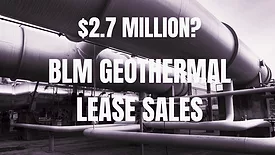Home » government policy
Articles Tagged with ''government policy''
Injection wells are used to safely dispose of liquid waste deep underground
Read More
DOE Halts 223 Energy Projects, Citing $7.5 Billion in Savings
Critics Warn of Lost Innovation
Read More
Breaking: JPMorgan’s $10 Billion Bet on National Security and Energy
Could Fuel U.S. Drilling and Mining Revival
Read More
New Report to Spotlight U.S. Mineral Supply Chain Weaknesses
Plus, the Debate Over Domestic Mining
Read More
Public Hearing on Asheboro Wastewater Permit Dispute
The City of Asheboro legally challenged NC DEQ’s authority to impose the 1,4-dioxane limit
Read More
Federal Shutdown Hits Colorado Hard as Energy Grants Are Canceled
These funds were expected to support initiatives ranging from methane reduction and grid modernization to renewable energy infrastructure
Read More
BLM Geothermal Lease Sales in California Generate More than $2.7M in Federal Revenue
Seven companies acquire leases in two counties ranging in price of $2 per acre to $247 per acre.
Read More
Construction Firm is Ordered to Clean Up Wastewater Discharges into Cane Garden Bay
Chitolie Trucking Service, LLC must come into compliance with the Clean Water Act after violations
Read More
EPA Cracks Down on Illegal Cesspools in Kauai to Protect Water Quality
Illegal Cesspools Pose Environmental Risks
Read More
REalloys Secures Major Rare Earth Supply Deal with St George Mining
Alliance boosts U.S. rare earth supply with Brazil’s Araxá Project.
Read More
Dig deeper into the drilling and water supply industry!
Build your knowledge with The Driller, covering the people, equipment and technologies across drilling markets.
SIGN UP NOWCopyright ©2025. All Rights Reserved BNP Media.
Design, CMS, Hosting & Web Development :: ePublishing










.webp?height=168&t=1759101148&width=275)
